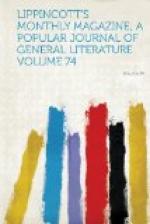Whenever the country became more wooded in its character, the bark-hunters, whose quest obliged them to stray in short flights around the wings of the column, redoubled their mazes. The careless air of these Bolivian retrievers, their voluntary doublings through the most difficult jungles, and their easy way of walking over everything with their noses in the air, proved well their indifference to the obstacles which were almost insurmountable to the rest.
[Illustration: The cones of Patabamba.]
Nothing could be more singular and interesting than to see them consulting one by one the indications scattered around them, and deciding on their probabilities or promises. Where the height and thickness of the foliage prevented them from seeing the sky, or even the shade of the surrounding green, they walked bent toward the ground, stirring up the rubbish, and choosing among the dead foliage certain leaves, of which they carefully examined the two sides and the stem. When by accident they found themselves near enough to speak to each other—a rare chance, for each peon undertook a separate line of search—they asked their friends, showing the leaves they had found, whether their discoveries appertained to the neighboring trees or whether the wind had brought the pieces from a distance. This kind of investigation, pursued by men who had prowled through forests all their lives, might seem slightly puerile if the reader does not understand that it is often difficult, or even impossible, to recognize the growing tree by its bark, covered as it is from base to branches with parasitic vegetation of every sort. In those forests whatever has a stout stem is used without scruple by the bignonias and air-plants, which race over the trunk, plant their root-claws in the cracks, leap over the whole tree at a single jet, or strangle it with multiplied knots, all the while adorning it with a superb mantle of leaves and blossoms. This is a difficulty which the most experienced cascarilleros are not able to overcome. As an instance, the history is cited of a practico or speculator who led an exploration for these trees in the valley of Apolobamba. After having caused to be felled, barked, measured, dried and trimmed all the cinchonas of one of those natural thickets called manchas—an operation which had occupied four months—he was about to abandon the spot and pursue the exploration elsewhere, when accident led him to discover, in the enormous trunk buried in creepers against which he had built his cabin, a Cinchona nitida, the forefather of all the trees he had stripped.
In this kind of search the caravan pursued the borders of the river, sometimes on this side and sometimes on that, now passing the two-headed mountain Camanti, now sighting the tufted peak of Basiri, now crossing the torrent called the Garote. In the latter, where the dam and hydraulic works of an old Spanish gold-hunter were still visible in a state of ruin, the sacred golden thirst of Colonel Perez once more attacked him. Two or three pins’ heads of the insane metal were actually unearthed by the colonel and displayed in a pie-dish; but the business of the party was one which made even the finding of gold insignificant, and they pursued their way.




